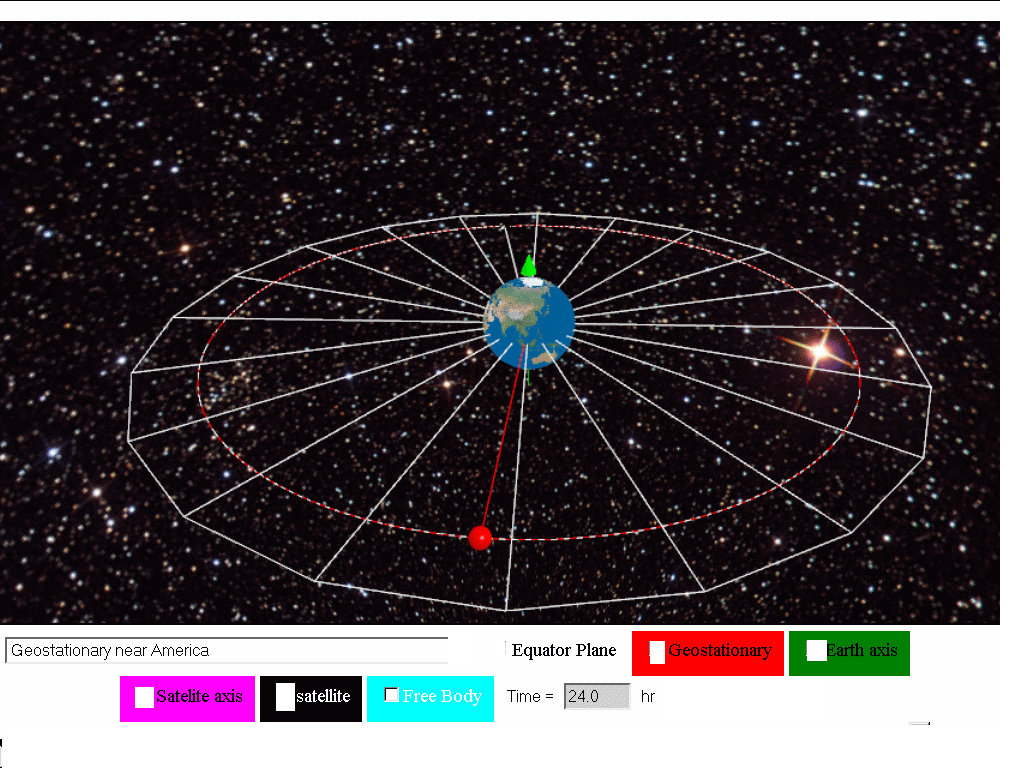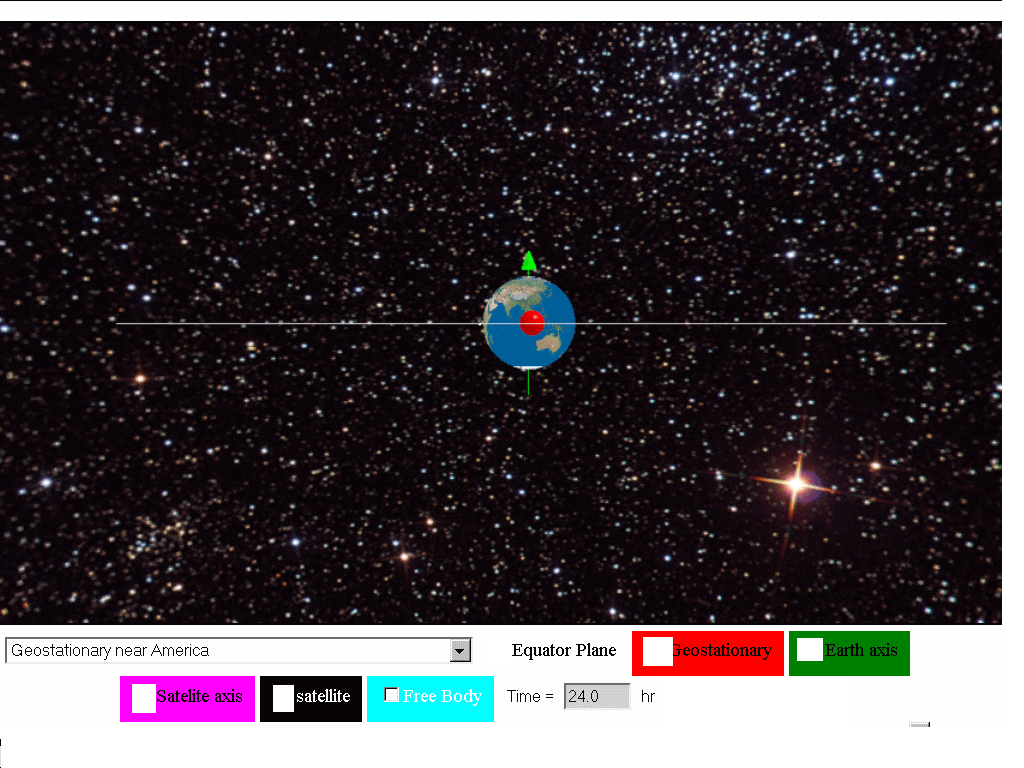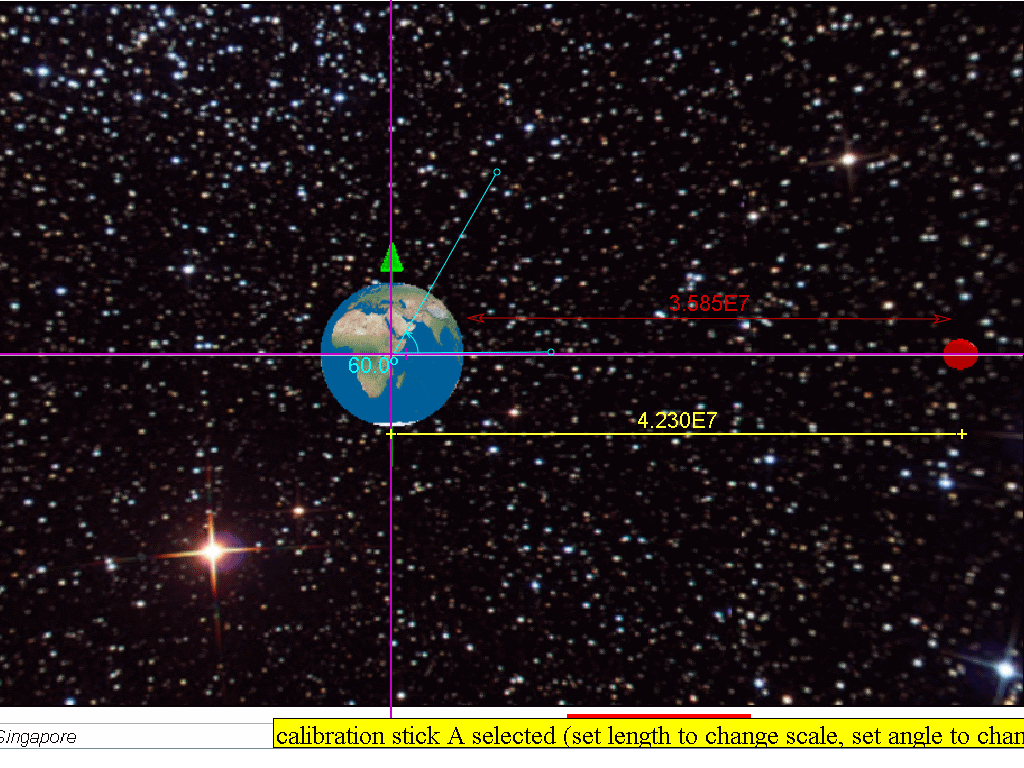Geostationary
Satellites
A geostationary (Earth) satellite is a satellite that rotates
around Earth in a certain orbit such that it is always positioned
above the same point on the Earth’s surface. Hence from the
point of view of an observer standing at that point, the
geostationary satellite appears to be always ‘stationary’ above
him/her (but actually, both observer and satellite are rotating at
the same angular speed). In order for a satellite to be moving in
such a geostationary orbit, there are certain conditions to
meet:

Characteristics
of Geostationary satellites
- placed vertically above the equator
- same direction sense as the rotation of the Earth (determine
through axis of rotation)
- same orbital period of Planet, in our case, Earth orbital
period of approximately 24 hrs
Determination
of height above Earth surface for geostationary orbit radius.
Analyzing the
free body diagram of a satellite traveling in a geostationary
oribt, we know the force on the satellite is assumed to be only
due to Earth's gravitational pull, the period is
approximately 24 hours = (24)(60)(60) = 86400 s
r = 4.23x107 m which is r =
3.59x107 +
6.37x106 m
which is why
Earth's geostationary satellites must be placed in an orbit
at a fixed distance (around 35 700 km) from the Earth’s surface,
in order to rotate with the same period as Earth.
Advantages
of geostationary satellites:

- A geostationary satellite is ideal for telecommunication
purposes since it remains ‘stationary’ above the same spot on
the Earth’s surface at all times. The distance between the
satellite and the transmitting station on Earth is kept
relatively constant and a clear line of ‘vision’ between the
transmitter and the receiver allows continuous and uninterrupted
signal transmission.
- Since it is always at the same relative position above the
Earth’s surface, there is no need to keep adjusting the
direction of the satellite dish to receive signals from the
geostationary satellite.
- As geostationary satellites are positioned at a high altitude
(a distance of 3.57 × 107 m away from the
surface of the Earth), it can view a large section of the Earth
and scan the same area frequently. Hence, they are ideal for
meteorological applications and remote imaging.
Disadvantages
of geostationary satellites:
- As geostationary satellites are positioned at such a high
altitude, the resolution of the images may not be as good as
those captured by the lower orbiting satellites (example shown
is polar orbits at R=1.133Rearth with orbital period
of 2 hours).
- Because of its high altitude, there may be a delay in the
reception of the signals resulting in a lag time for live
international broadcast or video conferencing.
 The
transmitting stations in countries positioned at latitudes
higher than 60 degrees may not be able to receive strong signals
from geostationary satellites, as the signals would have to pass
through a large amount of atmosphere. This is true for countries
beyond the 60 degrees latitude ‘belt’, both on north and south
sides.
The
transmitting stations in countries positioned at latitudes
higher than 60 degrees may not be able to receive strong signals
from geostationary satellites, as the signals would have to pass
through a large amount of atmosphere. This is true for countries
beyond the 60 degrees latitude ‘belt’, both on north and south
sides.
Besides geostationary satellites which are placed at a large
distance from Earth, there are other types of satellite which
orbit at lower altitudes from Earth, like the polar orbit
satellites as shown below.

Satellites in polar orbits rotate around
the Earth over the poles, in a constant plane perpendicular to the
equator. Polar satellites have much lower altitudes (about 850km
or R=1.133Rearth with
orbital period of 2 hour) which serve to provide more detailed
information about the weather and cloud formation. However
satellites in this type of orbit can view only a narrow strip of
Earth's surface on each orbit. Strips of images must be "stitched
together," to produce a larger view.
Example
Determine the typical orbital radius of
a geostationary satellite around Earth. (Given: mass of
Earth = 6.0 x 1024 kg)
Answer
The orbital period for geostationary
satellite = period of rotation of Earth = 24 hours
Thus, T = 24 hr x 60 min x 60 sec = 8.64
x 104 s
assuming that only the gravitational
force acts on the satellite moving in an ideal circular motion
acceleration
r = 4.23x107 m
Would
a geostationary satellite that orbit around planet Mars be at the
same distance r (= 4.2 x 107 m), be r = 4.23x107 m ? Why?
referring the data from https://en.wikipedia.org/wiki/Mars, MMars = 6.4185×1023 kg,
Sidereal rotation period T =1.025957 day.
r =2.04x107 m,
thus it is different due to the different planet mass and rotation
period
Example
(J2000/1/8)
Which quantity is not necessarily the
same for satellites that are in geostationary orbits around the
Earth?
A angular
velocity
C kinetic energy
B centripetal
acceleration
D orbital period
Answer C: Kinetic energy is dependent on
the satellite's mass and velocity. Hence different satellites of
different masses may have different kinetic energies.
the rest of choice must be same.
Example
A spacecraft was launched from Earth
into a circular orbit around Earth that was maintained at an
almost constant height of 189 km from the Earth's surface.
Assuming the gravitational field strength in this orbit is 9.4 N
kg-1, and the radius of the Earth is 6 370 km.
a) Calculate the speed of the
spacecraft in this orbit.
b) Find the time to complete one
orbit.
c) Comment whether this spacecraft
is in a geostationary orbit
since the condition for circular motion
is assumed to be true, we can use the circular motion equation
while also assuming only the Earth's gravitational field acts on
spacecraft.
rearranging to get
substituting
7.85x103 m/s
= v
b) since
and
substituting
T = 5249 = 5.25x103 s
c) since the spacecraft does not
satisfied just one of the condition (eg. T not 24 hours), it is
safe to conclude i cannot be geostationary.
- placed vertically above the equator
- same direction sense as the rotation of the Earth (determine
through axis of rotation)
- same orbital period of Planet, in our case, Earth orbital
period of approximately 24 hrs
Java
3D Model
http://iwant2study.org/lookangejss/02_newtonianmechanics_7gravity/ejs/ejs_model_EarthAndSatelite.jar
Model
https://dl.dropboxusercontent.com/u/44365627/lookangEJSworkspace/export/ejss_model_gravity10/gravity10_Simulation.xhtml
Geostationary
Satellite around Earth Model
This
Geostationary Satellite around Earth Model is a simple angular
velocity model that uses the Java3D implementation for realistic
visualization of satellite objects in geostationary orbits at
three different locations namely (near Singapore, near Africa and
America . Students can explore the meaning of geostationary
orbits, cases of non-geostationary orbits and even non-gravity
physics orbit .
Geostationary
Satellites
The term
Geo-stationary implies a satellite fixed about a position above
the earth. This is possible because such satellites have the same
period as the Earth’s rotation 1 (T = 24 hours) 2 same rotational
sense as the earth's rotation spin 3 is directly above the equator
in other words the plane of rotation of the satellite must be in
the plane of the Equator Therefore, it appears stationary.
Application
Example of
geostationary satellites are GMS1, GEOS, METEOSAT etc. Most of
these satellites are used for commercial and military
purposes
Main
Simulation View
The simulation
has a Earth and a Satellite object Menu Drop Down Allows for
selecting what motion of Satellite is simulated.
- Geostationary near sg
- Geostationary near Africa
- Geostationary near America
- Non-geostationary due to direction
- circular motion r=3*Re, T =7.30 hr
- circular motion r=10.5*Re, T = 48 hr
- Non-Geostationary generally
- Unlikely Orbits
Checkboxes
- show:equator Plane, for visualizing the Earth's rotating
equator plane
- Geo stationary, for visualizing a geostationary object (RED)
for comparative observation with the other modes.
- Show text: 35 700 km fixed position of object relative to
planet earth.
- Axes earth: show spin axes of the rotation of earth in GREEN
- Axes satellite: show spin axes of the rotation of satellite in
MAGENTA
- Force: pair of action reaction force of equal magnitude,
opposite direction and on different bodies. (Newton's 3rd
Law)
Buttons
- Play
- Step Forward
- Reset
have their usual meaning.



 The
transmitting stations in countries positioned at latitudes
higher than 60 degrees may not be able to receive strong signals
from geostationary satellites, as the signals would have to pass
through a large amount of atmosphere. This is true for countries
beyond the 60 degrees latitude ‘belt’, both on north and south
sides.
The
transmitting stations in countries positioned at latitudes
higher than 60 degrees may not be able to receive strong signals
from geostationary satellites, as the signals would have to pass
through a large amount of atmosphere. This is true for countries
beyond the 60 degrees latitude ‘belt’, both on north and south
sides.